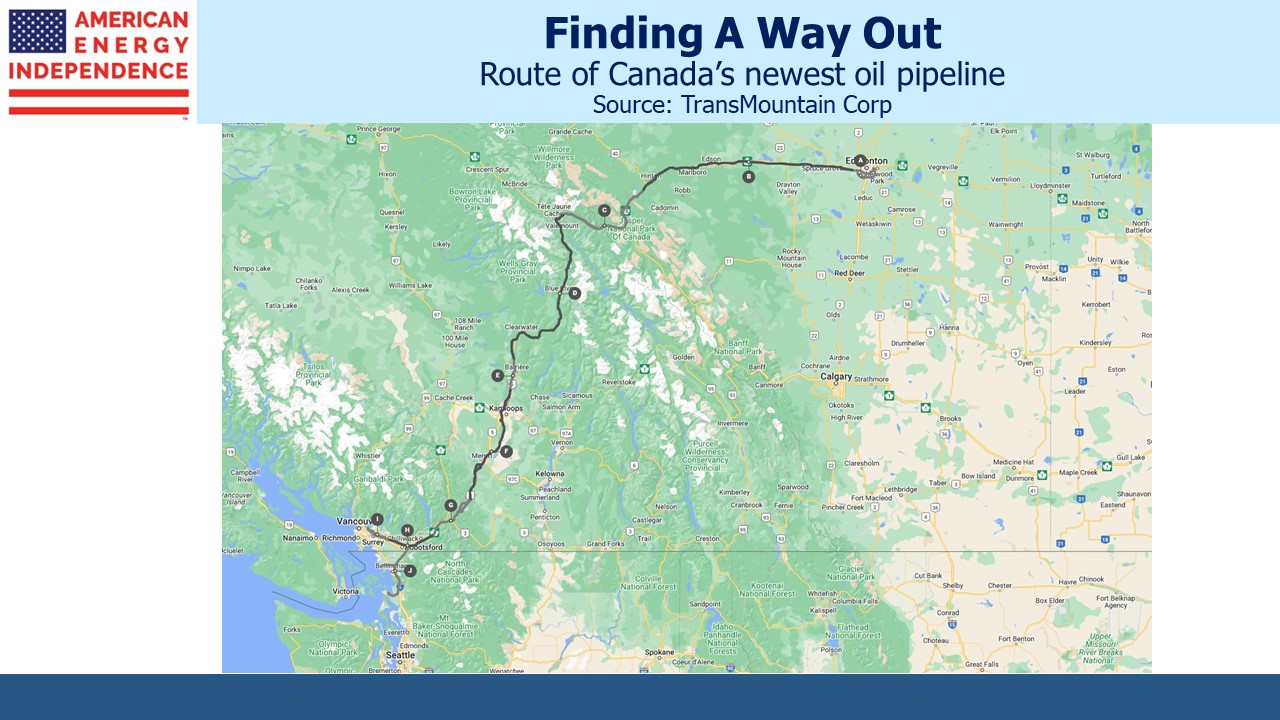A Closer Look At Canada’s Newest Pipeline
I was perusing energy podcasts the other day. Disappointingly they all seemed to be about renewables – nothing about where over 80% of the world’s energy comes from today. Hopefully I started listening to one by Shell, but quickly realized it’s part of their PR campaign to convince people they’re fully committed to the energy transition while they struggle to make any money outside of their fossil fuels business.
Then I stumbled on an interview with Dawn Farrell, President and CEO of Trans Mountain Corporation (TMC). Originally called TMX, this was a project begun by Kinder Morgan to expand crude capacity on the existing pipeline connecting Edmonton, Alberta with Burnaby, British Columbia.
As we chronicled several times over the years (see Canada’s Failing Energy Strategy), Kinder Morgan eventually tired of navigating the politics between oil-rich Alberta and liberal British Columbia. Canada has long struggled to get its crude oil to market. The Keystone XL expansion was finally killed off by Joe Biden as soon as he became president in a slap to our ally. The Western Canada Sedimentary Basin crude benchmark trades below WTI – sometimes as much as $30. The Canadian Federal government decided completing TMX was in the national interest and bought it from KMI in 2018.
It is now finished. Dawn Farrell explains what it was like to oversee a project backed with theoretically unlimited government funds.
The cost grew from an estimated C$7BN to C$29BN (C$34BN including interest expense), although Farrell notes that the scope increased somewhat. The complexity of building infrastructure isn’t always apparent to those not directly involved.
The route included 47KM of steep slopes with a 15% grade. If not correctly built the pipeline will over time come apart in such terrain. Oil is moved through pipelines in batches of varying grades. Nitrogen has to be inserted between each batch to ensure no gaps open up in between them.
Farrell said they encountered 360 archeological sites, making them probably the largest dig in Canadian history. Every time a new one was encountered work stopped while archeologists were brought in.
Representatives of First Nations, Canada’s indigenous people, were involved at every step. They have stronger rights that native Americans and their consent was needed at numerous points for the project to proceed. TMC employed an ambassador who spent countless days courting First Nations leaders. They were awarded 10% of the jobs and may eventually own a stake in TMC.
Archeologists uncovered 250K artifacts that were mostly First Nations ancestors dating back as much as 1,500 years.
TMC moved 27,000 birds’ nests. They relocated 1.5 million amphibians. Biologists were ever present supervising the process. They passed through nine golf courses, all of which Farrell reports were restored to their previous condition. They met the needs of 69 regulatory agencies.
TMC expanded the oil loading facilities at Vancouver. An estimated 100 whales live in nearby waters, so all ships operate at lower-than-normal speed and employ specialized sonar which is audible to whales, reducing the odds of contact.
TMC increased TransMountain’s capacity from 300 Thousand Barrels per Day (KB/D) to 890KB/D. Filling the pipeline took 24 days and 4.2 million barrels of oil, but it’s now operational.
Canadian politics is more liberal than the US, but there are still plenty of realists up north who recognize that the world will need gasoline, jet fuel, diesel, lubricants and asphalt for the rest of our lives.
The cancelation of Keystone XL was intended to appease climate extremists, but it didn’t stop Canadian oil getting to market. It’s simply going west instead of south, with no US benefit. Similarly, the LNG permit pause won’t stop countries buying natural gas, but it will increase coal consumption by emerging countries in Asia. Democrat energy policies are often more about optics than results.
TMC was a huge infrastructure project with numerous stakeholders including landowners, regulators, oil shippers, indigenous tribes and environmentalists. Past struggles include: Energy Transfer’s Dakota Access pipeline which was fiercely opposed by indigenous tribes; Equitrans’ Mountain Valley Pipeline which suffered numerous judicial delays; and the Cardinal-Hickory Creek transmission line which environmentalists opposed even though it will bring solar and wind power to population centers in Iowa and Wisconsin.
TMX in China would have been different. Building energy infrastructure in rich, western countries is excruciatingly complex. Federal permit reform has support from both political parties but remains unaddressed. Until the process is improved it will impede the energy transition. There’s much more of this ahead for western nations as we electrify more of our energy consumption.
We have three have funds that seek to profit from this environment:
